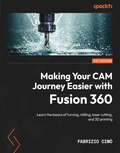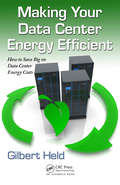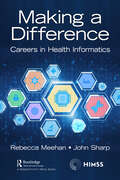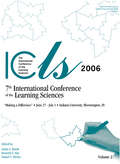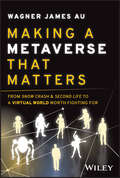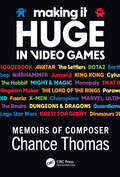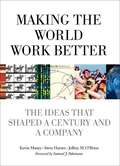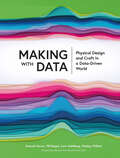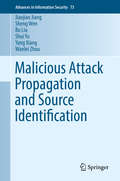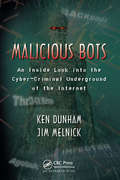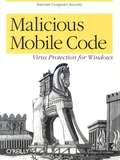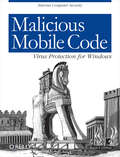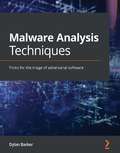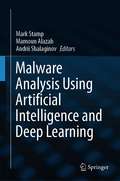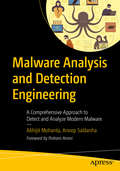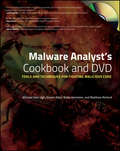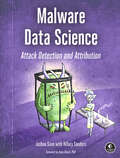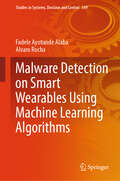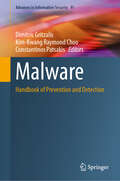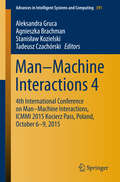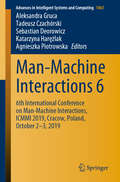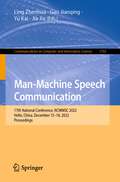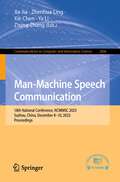- Table View
- List View
Making Your CAM Journey Easier with Fusion 360: Learn the basics of turning, milling, laser cutting, and 3D printing
by Fabrizio CimoTurn your design ideas into 3D models using Fusion 360 by honing your design skills and learning the best practices of common production technologiesPurchase of the print or Kindle book includes a free PDF eBookKey FeaturesGet familiar with Fusion 360 CAM Module and its machining potential with hands-on exercisesExplore major production technologies like turning, milling, laser cutting, and additive manufacturingLearn how to setup your program and simulate stock removalBook DescriptionDownloading a piece of 3D software and shaping concepts and ideas is quite easy. However, designing feasible and cost-effective real parts from 3D models can be challenging with traditional production technologies, or even additive manufacturing. This book will give you the know-how and skills to develop your projects from ideas to physical products, and overcome these obstacles.In 'Making Your CAM Journey Easier with Fusion 360', you'll discover how to set up a CAM program, pick the right tool, and optimize production. You'll learn the pros and cons of different production technologies, including turning, milling, laser cutting, and 3D printing, and understand how to choose the best option based on your needs. You'll also explore the important computer-aided manufacturing tools that Fusion 360 offers through the use of examples and best practices.By the end of this book, you'll understand the potential issues and drawbacks of different design components and apply workarounds to avoid design flaws.What you will learnChoose the best approach for different parts and shapesAvoid design flaws from a manufacturing perspectiveDiscover the different machining strategiesUnderstand how different tool geometries can influence machining resultsDiscover how to check the tool simulation for errorsUnderstand possible fixtures for raw material blocksBecome proficient in optimizing parameters for your machineExplore machining theory and formulas to evaluate cutting parametersWho this book is forThis book is for 3D enthusiasts or mechanical designers looking to turn their design ideas into 3D models, and their 3D models into final products. Familiarity with any CAD software or Fusion 360 design module is recommended; the book will then teach you the rest.
Making Your Data Center Energy Efficient
by Gilbert HeldDetailing powerful methods for reducing the energy costs associated with operating a data center, Making Your Data Center Energy Efficient examines both equipment and building facilities. It reviews the rationale for conserving energy and demonstrates how conservation and careful equipment selection can lead to significant improvements to your bottom line. For those not well-versed in financial or energy terms, the first two chapters provide a detailed discussion of the terms associated with different types of energy, as well as how to compute the return on investment for energy conservation efforts. The text includes tables of monthly expenses associated with operating equipment that will help you convert problems into simple table lookup processes. Among the money-saving topics discussed, it considers: How to minimize the energy consumption of a wide range of devices A little-understood topic that can make a big impact on energy costs-general heating and cooling Techniques required to effectively monitor different types of meters Phantom energy usage and methods for minimizing its cost to your organization Recognizing that most readers may not have direct control over the selection of a furnace or hot water heater, the book provides you with the ability to recognize the efficiencies and inefficiencies of various types of devices, so you can provide input into the decision-making process. From replacing lighting to consolidation and virtualization, it provides you with the well-rounded understanding needed to properly manage all aspects of the energy consumed in your data center.
Making Your Primary School E-safe: Whole School Cyberbullying and E-safety Strategies for Meeting Ofsted Requirements
by Adrienne KatzChildren are using the internet and mobile devices at increasingly younger ages, and it's becoming more and more important to address e-safety in primary schools. This practical book provides guidance on how to teach and promote e-safety and tackle cyberbullying with real-life examples from schools of what works and what schools need to do. The book explains how to set policy and procedures, how to train staff and involve parents, and provides practical strategies and ready-to-use activities for teaching e-safety and meeting Ofsted requirements. Including up-to-the-minute information and advice that includes new technologies, social media sites, and recent school policy trends such as 'Bring Your Own Device', this book provides all of the information that educational professionals need to implement successful whole school e-safety strategies.
Making a Difference: Careers in Health Informatics (HIMSS Book Series)
by John Sharp Rebecca MeehanMaking a Difference: Careers in Health Informatics addresses everyday questions from people interested in working in health informatics. Typically, this includes people who work in health care, computer and technology fields, information science, finance / insurance and related areas. The book aims to tell students about various jobs that exist in the health informatics field, what credentials they need to qualify for those jobs, and a brief description about what people in those roles tend to do every day. As faculty members teaching in a Master of Science in Health Informatics program, the authors say that they are fortunate to have eager, bright, and talented graduate students who are invested in related health informatics areas. This could be their experiences in medicine, nursing, clinical care, software engineering, finance, business, library science, data science, or caregiving. Common questions we hear from our students that may be similar to questions among readers include: ‘what jobs are out there?’, ‘what can I do with this degree?’ or ‘what does a health informatics specialist do?’ This book aims to answer some of these questions with a look into a day in the life of people working in this field. The book examines career options, roles, and skill sets important in health informatics across 6 related industries. We want readers to realize that their skills and interests can apply in many areas of the field, not exclusively hospitals. This book highlights 6 unique work segments (hospital systems, long term care, health IT / consumer health organizations, government, consulting, and payer / insurance companies) into which readers may look to expand their career opportunities. The hope is that this book will provide insight into career opportunities students and professionals may be qualified for, and interested in, but simply not aware of. Hiring managers and human resource professionals across the stakeholder groups across the stakeholder groups may also find the book helpful in learning about other roles that may benefit their organizations.
Making a Difference: The Proceedings of the Seventh International Conference of the Learning Sciences (ICLS)
by Sasha A. Barab Kenneth E. Hay Daniel T. HickeyFirst published in 2006. Routledge is an imprint of Taylor & Francis, an informa company.
Making a Metaverse That Matters: From Snow Crash & Second Life to A Virtual World Worth Fighting For
by Wagner James AuAn up-close account from the world’s first metaverse-embedded reporter In Making a Metaverse That Matters: From Snow Crash & Second Life to A Virtual World Worth Fighting For, the celebrated author of The Making of Second Life and Game Design Secrets, Wagner James Au, delivers an engrossing exploration of how nascent metaverse platforms have already captured the imagination of millions. Featuring powerful stories and dozens of incisive interviews with insiders including Metaverse creator Neal Stephenson himself, the author uses his unique, grassroots-level perspective as the first reporter embedded in a metaverse platform. Readers will learn about: How to understand and define the Metaverse and cut through the many myths and misconceptions around it. A behind-the-scenes account of launching Second Life, the first metaverse platform to achieve mainstream awareness, and what its many controversies teach us. Where current platforms Meta, Roblox, Fortnite, VRChat, and Lamina1, Neal Stephenson’s own metaverse startup, fit in the ecosystem. How to address the many dangers inherent in the Metaverse before it becomes central to the Internet. Perfect for XR industry members and indie creatives, Making a Metaverse That Matters is also for tech professionals, virtual world communities, and anyone interested in the future of culture and commerce.
Making it HUGE in Video Games: Memoirs of Composer Chance Thomas
by Chance ThomasMaking it HUGE in Video Games recounts the astonishing journey of an unassuming, middle-of-the-bell-curve young man, rising from mundane beginnings to scale the dizzying heights of artistic distinction and financial success in the worldwide video game industry.This is the story of Chance Thomas, a moderately talented musician who struggled and grew to compose original scores for some of the most well-known entertainment properties in the world. Detailed personal accounts and instructive side bars carry readers across the jagged peaks and valleys of an absolutely achievable career in video games. World-famous IP’s get personal treatment here – The Lord of the Rings, Marvel, Avatar, Dungeons & Dragons, Warhammer, DOTA 2, King Kong, The Settlers, and many more.Readers will discover unvarnished true stories about starting out, pitching and pursuing gigs, negotiating contracts, composing and producing scores, multinational corporations and personalities, funny anecdotes, daunting challenges, glorious successes, and instructive failures. Autobiographical details throughout provide intimate perspective, vibrant color, and inspiration. The book is written in a comfortable, conversational style.Think of this as a career guidebook wrapped around a personal retrospective; a professional how-to manual woven into a memoir.
Making the World Work Better: The Ideas That Shaped a Century and a Company
by Kevin Maney Steve Hamm Jeffrey O'BrienThomas J Watson Sr’s motto for IBM was THINK, and for more than a century, that one little word worked overtime. In Making the World Work Better: The Ideas That Shaped a Century and a Company , journalists Kevin Maney, Steve Hamm, and Jeffrey M. O’Brien mark the Centennial of IBM’s founding by examining how IBM has distinctly contributed to the evolution of technology and the modern corporation over the past 100 years. <p><p> The authors offer a fresh analysis through interviews of many key figures, chronicling the Nobel Prize-winning work of the company’s research laboratories and uncovering rich archival material, including hundreds of vintage photographs and drawings. The book recounts the company’s missteps, as well as its successes. It captures moments of high drama – from the bet-the-business gamble on the legendary System/360 in the 1960s to the turnaround from the company’s near-death experience in the early 1990s. <p> The authors have shaped a narrative of discoveries, struggles, individual insights and lasting impact on technology, business and society. Taken together, their essays reveal a distinctive mindset and organizational culture, animated by a deeply held commitment to the hard work of progress. IBM engineers and scientists invented many of the building blocks of modern information technology, including the memory chip, the disk drive, the scanning tunneling microscope (essential to nanotechnology) and even new fields of mathematics. IBM brought the punch-card tabulator, the mainframe and the personal computer into the mainstream of business and modern life. IBM was the first large American company to pay all employees salaries rather than hourly wages, an early champion of hiring women and minorities and a pioneer of new approaches to doing business--with its model of the globally integrated enterprise. And it has had a lasting impact on the course of society from enabling the US Social Security System, to the space program, to airline reservations, modern banking and retail, to many of the ways our world today works. <p> The lessons for all businesses – indeed, all institutions – are powerful: To survive and succeed over a long period, you have to anticipate change and to be willing and able to continually transform. But while change happens, progress is deliberate. IBM – deliberately led by a pioneering culture and grounded in a set of core ideas – came into being, grew, thrived, nearly died, transformed itself… and is now charting a new path forward for its second century toward a perhaps surprising future on a planetary scale.
Making with Data: Physical Design and Craft in a Data-Driven World (AK Peters Visualization Series)
by Samuel Huron Till Nagel Lora Oehlberg Wesley WillettHow can we give data physical form? And how might those creations change the ways we experience data and the stories it can tell? Making with Data: Physical Design and Craft in a Data-Driven World provides a snapshot of the diverse practices contemporary creators are using to produce objects, spaces, and experiences imbued with data. Across 25+ beautifully-illustrated chapters, international artists, designers, and scientists each explain the process of creating a specific data-driven piece—illustrating their practice with candid sketches, photos, and design artifacts from their own studios. Featuring influential voices in computer science, data science, graphic design, art, craft, and architecture, Making with Data is accessible and inspiring for enthusiasts and experts alike.
Malicious Attack Propagation and Source Identification (Advances in Information Security #73)
by Bo Liu Yang Xiang Shui Yu Wanlei Zhou Sheng Wen Jiaojiao JiangThis book covers and makes four major contributions: 1) analyzing and surveying the pros and cons of current approaches for identifying rumor sources on complex networks; 2) proposing a novel approach to identify rumor sources in time-varying networks; 3) developing a fast approach to identify multiple rumor sources; 4) proposing a community-based method to overcome the scalability issue in this research area. These contributions enable rumor source identification to be applied effectively in real-world networks, and eventually diminish rumor damages, which the authors rigorously illustrate in this book. In the modern world, the ubiquity of networks has made us vulnerable to various risks. For instance, viruses propagate throughout the Internet and infect millions of computers. Misinformation spreads incredibly fast in online social networks, such as Facebook and Twitter. Infectious diseases, such as SARS, H1N1 or Ebola, have spread geographically and killed hundreds of thousands people. In essence, all of these situations can be modeled as a rumor spreading through a network, where the goal is to find the source of the rumor so as to control and prevent network risks. So far, extensive work has been done to develop new approaches to effectively identify rumor sources. However, current approaches still suffer from critical weaknesses. The most serious one is the complex spatiotemporal diffusion process of rumors in time-varying networks, which is the bottleneck of current approaches. The second problem lies in the expensively computational complexity of identifying multiple rumor sources. The third important issue is the huge scale of the underlying networks, which makes it difficult to develop efficient strategies to quickly and accurately identify rumor sources. These weaknesses prevent rumor source identification from being applied in a broader range of real-world applications. This book aims to analyze and address these issues to make rumor source identification more effective and applicable in the real world. The authors propose a novel reverse dissemination strategy to narrow down the scale of suspicious sources, which dramatically promotes the efficiency of their method. The authors then develop a Maximum-likelihood estimator, which can pin point the true source from the suspects with high accuracy. For the scalability issue in rumor source identification, the authors explore sensor techniques and develop a community structure based method. Then the authors take the advantage of the linear correlation between rumor spreading time and infection distance, and develop a fast method to locate the rumor diffusion source. Theoretical analysis proves the efficiency of the proposed method, and the experiment results verify the significant advantages of the proposed method in large-scale networks. This book targets graduate and post-graduate students studying computer science and networking. Researchers and professionals working in network security, propagation models and other related topics, will also be interested in this book.
Malicious Bots: An Inside Look into the Cyber-Criminal Underground of the Internet
by Ken Dunham Jim MelnickOriginally designed as neutral entities, computerized bots are increasingly being used maliciously by online criminals in mass spamming events, fraud, extortion, identity theft, and software theft. Malicious Bots: An Inside Look into the Cyber-Criminal Underground of the Internet explores the rise of dangerous bots and exposes the nefarious methods of "botmasters". This valuable resource assists information security managers in understanding the scope, sophistication, and criminal uses of bots. With sufficient technical detail to empower IT professionals, this volume provides in-depth coverage of the top bot attacks against financial and government networks over the last several years. The book presents exclusive details of the operation of the notorious Thr34t Krew, one of the most malicious bot herder groups in recent history. Largely unidentified by anti-virus companies, their bots spread globally for months, launching massive distributed denial of service (DDoS) attacks and warez (stolen software distributions). For the first time, this story is publicly revealed, showing how the botherders got arrested, along with details on other bots in the world today. Unique descriptions of the criminal marketplace - how criminals make money off of your computer - are also a focus of this exclusive book! With unprecedented detail, the book goes on to explain step-by-step how a hacker launches a botnet attack, providing specifics that only those entrenched in the cyber-crime investigation world could possibly offer. Authors Ken Dunham and Jim Melnick serve on the front line of critical cyber-attacks and countermeasures as experts in the deployment of geopolitical and technical bots. Their work involves advising upper-level government officials and executives who control some of the largest networks in the world. By examining the methods of Internet predators, information security managers will be better able to proactively protect their own networks from such attacks.
Malicious Mobile Code
by Roger A. GrimesMalicious mobile code is a new term to describe all sorts of destructive programs: viruses, worms, Trojans, and rogue Internet content. Until fairly recently, experts worried mostly about computer viruses that spread only through executable files, not data files, and certainly not through email exchange. The Melissa virus and the Love Bug proved the experts wrong, attacking Windows computers when recipients did nothing more than open an email. Today, writing programs is easier than ever, and so is writing malicious code. The idea that someone could write malicious code and spread it to 60 million computers in a matter of hours is no longer a fantasy. The good news is that there are effective ways to thwart Windows malicious code attacks, and author Roger Grimes maps them out in Malicious Mobile Code: Virus Protection for Windows. His opening chapter on the history of malicious code and the multi-million dollar anti-virus industry sets the stage for a comprehensive rundown on today's viruses and the nuts and bolts of protecting a system from them. He ranges through the best ways to configure Windows for maximum protection, what a DOS virus can and can't do, what today's biggest threats are, and other important and frequently surprising information. For example, how many people know that joining a chat discussion can turn one's entire computer system into an open book? Malicious Mobile Code delivers the strategies, tips, and tricks to secure a system against attack. It covers: The current state of the malicious code writing and cracker community How malicious code works, what types there are, and what it can and cannot do Common anti-virus defenses, including anti-virus software How malicious code affects the various Windows operating systems, and how to recognize, remove, and prevent it Macro viruses affecting MS Word, MS Excel, and VBScript Java applets and ActiveX controls Enterprise-wide malicious code protection Hoaxes The future of malicious mobile code and how to combat such code These days, when it comes to protecting both home computers and company networks against malicious code, the stakes are higher than ever. Malicious Mobile Code is the essential guide for securing a system from catastrophic loss.
Malicious Mobile Code: Virus Protection for Windows
by Roger A. Grimes"Malicious mobile code" is a new term to describe all sorts of destructive programs: viruses, worms, trojans, and rogue Internet content. Malicious mobile code is more prevalent today than ever before, and both home users and system administrators need to be on the alert to protect their network or company against attacks. Malicious Mobile Code reveals what such code can and can't do and how to recognize, remove, and prevent it. Readers learn effective strategies, tips, and tricks for securing any system.
Malicious Mobile Code: Virus Protection for Windows
by Roger A. GrimesMalicious mobile code is a new term to describe all sorts of destructive programs: viruses, worms, Trojans, and rogue Internet content. Until fairly recently, experts worried mostly about computer viruses that spread only through executable files, not data files, and certainly not through email exchange. The Melissa virus and the Love Bug proved the experts wrong, attacking Windows computers when recipients did nothing more than open an email. Today, writing programs is easier than ever, and so is writing malicious code. The idea that someone could write malicious code and spread it to 60 million computers in a matter of hours is no longer a fantasy.The good news is that there are effective ways to thwart Windows malicious code attacks, and author Roger Grimes maps them out inMalicious Mobile Code: Virus Protection for Windows. His opening chapter on the history of malicious code and the multi-million dollar anti-virus industry sets the stage for a comprehensive rundown on today's viruses and the nuts and bolts of protecting a system from them. He ranges through the best ways to configure Windows for maximum protection, what a DOS virus can and can't do, what today's biggest threats are, and other important and frequently surprising information. For example, how many people know that joining a chat discussion can turn one's entire computer system into an open book?Malicious Mobile Code delivers the strategies, tips, and tricks to secure a system against attack. It covers:The current state of the malicious code writing and cracker communityHow malicious code works, what types there are, and what it can and cannot doCommon anti-virus defenses, including anti-virus softwareHow malicious code affects the various Windows operating systems, and how to recognize, remove, and prevent itMacro viruses affecting MS Word, MS Excel, and VBScriptJava applets and ActiveX controlsEnterprise-wide malicious code protectionHoaxesThe future of malicious mobile code and how to combat such codeThese days, when it comes to protecting both home computers and company networks against malicious code, the stakes are higher than ever.Malicious Mobile Code is the essential guide for securing a system from catastrophic loss.
Malware Analysis Techniques: Tricks for the triage of adversarial software
by Dylan BarkerAnalyze malicious samples, write reports, and use industry-standard methodologies to confidently triage and analyze adversarial software and malwareKey FeaturesInvestigate, detect, and respond to various types of malware threatUnderstand how to use what you've learned as an analyst to produce actionable IOCs and reportingExplore complete solutions, detailed walkthroughs, and case studies of real-world malware samplesBook DescriptionMalicious software poses a threat to every enterprise globally. Its growth is costing businesses millions of dollars due to currency theft as a result of ransomware and lost productivity. With this book, you'll learn how to quickly triage, identify, attribute, and remediate threats using proven analysis techniques. Malware Analysis Techniques begins with an overview of the nature of malware, the current threat landscape, and its impact on businesses. Once you've covered the basics of malware, you'll move on to discover more about the technical nature of malicious software, including static characteristics and dynamic attack methods within the MITRE ATT&CK framework. You'll also find out how to perform practical malware analysis by applying all that you've learned to attribute the malware to a specific threat and weaponize the adversary's indicators of compromise (IOCs) and methodology against them to prevent them from attacking. Finally, you'll get to grips with common tooling utilized by professional malware analysts and understand the basics of reverse engineering with the NSA's Ghidra platform. By the end of this malware analysis book, you'll be able to perform in-depth static and dynamic analysis and automate key tasks for improved defense against attacks.What you will learnDiscover how to maintain a safe analysis environment for malware samplesGet to grips with static and dynamic analysis techniques for collecting IOCsReverse-engineer and debug malware to understand its purposeDevelop a well-polished workflow for malware analysisUnderstand when and where to implement automation to react quickly to threatsPerform malware analysis tasks such as code analysis and API inspectionWho this book is forThis book is for incident response professionals, malware analysts, and researchers who want to sharpen their skillset or are looking for a reference for common static and dynamic analysis techniques. Beginners will also find this book useful to get started with learning about malware analysis. Basic knowledge of command-line interfaces, familiarity with Windows and Unix-like filesystems and registries, and experience in scripting languages such as PowerShell, Python, or Ruby will assist with understanding the concepts covered.
Malware Analysis Using Artificial Intelligence and Deep Learning
by Mark Stamp Mamoun Alazab Andrii ShalaginovThis book is focused on the use of deep learning (DL) and artificial intelligence (AI) as tools to advance the fields of malware detection and analysis. The individual chapters of the book deal with a wide variety of state-of-the-art AI and DL techniques, which are applied to a number of challenging malware-related problems. DL and AI based approaches to malware detection and analysis are largely data driven and hence minimal expert domain knowledge of malware is needed.This book fills a gap between the emerging fields of DL/AI and malware analysis. It covers a broad range of modern and practical DL and AI techniques, including frameworks and development tools enabling the audience to innovate with cutting-edge research advancements in a multitude of malware (and closely related) use cases.
Malware Analysis and Detection Engineering: A Comprehensive Approach to Detect and Analyze Modern Malware
by Abhijit Mohanta Anoop SaldanhaDiscover how the internals of malware work and how you can analyze and detect it. You will learn not only how to analyze and reverse malware, but also how to classify and categorize it, giving you insight into the intent of the malware. Malware Analysis and Detection Engineering is a one-stop guide to malware analysis that simplifies the topic by teaching you undocumented tricks used by analysts in the industry. You will be able to extend your expertise to analyze and reverse the challenges that malicious software throws at you. The book starts with an introduction to malware analysis and reverse engineering to provide insight on the different types of malware and also the terminology used in the anti-malware industry. You will know how to set up an isolated lab environment to safely execute and analyze malware. You will learn about malware packing, code injection, and process hollowing plus how to analyze, reverse, classify, and categorize malware using static and dynamic tools. You will be able to automate your malware analysis process by exploring detection tools to modify and trace malware programs, including sandboxes, IDS/IPS, anti-virus, and Windows binary instrumentation.The book provides comprehensive content in combination with hands-on exercises to help you dig into the details of malware dissection, giving you the confidence to tackle malware that enters your environment.What You Will LearnAnalyze, dissect, reverse engineer, and classify malwareEffectively handle malware with custom packers and compilersUnpack complex malware to locate vital malware components and decipher their intentUse various static and dynamic malware analysis tools Leverage the internals of various detection engineering tools to improve your workflow Write Snort rules and learn to use them with Suricata IDS Who This Book Is ForSecurity professionals, malware analysts, SOC analysts, incident responders, detection engineers, reverse engineers, and network security engineers"This book is a beast! If you're looking to master the ever-widening field of malware analysis, look no further. This is the definitive guide for you." Pedram Amini, CTO Inquest; Founder OpenRCE.org and ZeroDayInitiative
Malware Analyst's Cookbook and DVD
by Blake Hartstein Steven Adair Michael Ligh Matthew RichardA computer forensics "how-to" for fighting malicious code and analyzing incidentsWith our ever-increasing reliance on computers comes an ever-growing risk of malware. Security professionals will find plenty of solutions in this book to the problems posed by viruses, Trojan horses, worms, spyware, rootkits, adware, and other invasive software. Written by well-known malware experts, this guide reveals solutions to numerous problems and includes a DVD of custom programs and tools that illustrate the concepts, enhancing your skills.Security professionals face a constant battle against malicious software; this practical manual will improve your analytical capabilities and provide dozens of valuable and innovative solutionsCovers classifying malware, packing and unpacking, dynamic malware analysis, decoding and decrypting, rootkit detection, memory forensics, open source malware research, and much moreIncludes generous amounts of source code in C, Python, and Perl to extend your favorite tools or build new ones, and custom programs on the DVD to demonstrate the solutionsMalware Analyst's Cookbook is indispensible to IT security administrators, incident responders, forensic analysts, and malware researchers.
Malware Data Science: Attack Detection and Attribution
by Joshua Saxe Hillary SandersMalware Data Science explains how to identify, analyze, and classify large-scale malware using machine learning and data visualization.Security has become a "big data" problem. The growth rate of malware has accelerated to tens of millions of new files per year while our networks generate an ever-larger flood of security-relevant data each day. In order to defend against these advanced attacks, you'll need to know how to think like a data scientist. In Malware Data Science, security data scientist Joshua Saxe introduces machine learning, statistics, social network analysis, and data visualization, and shows you how to apply these methods to malware detection and analysis. You'll learn how to:- Analyze malware using static analysis- Observe malware behavior using dynamic analysis- Identify adversary groups through shared code analysis- Catch 0-day vulnerabilities by building your own machine learning detector- Measure malware detector accuracy- Identify malware campaigns, trends, and relationships through data visualization Whether you're a malware analyst looking to add skills to your existing arsenal, or a data scientist interested in attack detection and threat intelligence, Malware Data Science will help you stay ahead of the curve.
Malware Detection on Smart Wearables Using Machine Learning Algorithms (Studies in Systems, Decision and Control #549)
by Alvaro Rocha Fadele Ayotunde AlabaThis book digs into the important confluence of cybersecurity and big data, providing insights into the ever-changing environment of cyber threats and solutions to protect these enormous databases. In the modern digital era, large amounts of data have evolved into the vital organs of businesses, providing the impetus for decision-making, creativity, and a competitive edge. Cyberattacks pose a persistent danger to this important resource since they can result in data breaches, financial losses, and harm to an organization's brand.
Malware: Handbook of Prevention and Detection (Advances in Information Security #91)
by Kim-Kwang Raymond Choo Dimitris Gritzalis Constantinos PatsakisThis book provides a holistic overview of current state of the art and practice in malware research as well as the challenges of malware research from multiple angles. It also provides step-by-step guides in various practical problems, such as unpacking real-world malware and dissecting it to collect and perform a forensic analysis. Similarly, it includes a guide on how to apply state-of-the-art Machine Learning methods to classify malware. Acknowledging that the latter is a serious trend in malware, one part of the book is devoted to providing the reader with the state-of-the-art in Machine Learning methods in malware classification, highlighting the different approaches that are used for, e.g., mobile malware samples and introducing the reader to the challenges that are faced when shifting from a lab to production environment. Modern malware is fueling a worldwide underground economy. The research for this book is backed by theoretical models that simulate how malware propagates and how the spread could be mitigated. The necessary mathematical foundations and probabilistic theoretical models are introduced, and practical results are demonstrated to showcase the efficacy of such models in detecting and countering malware. It presents an outline of the methods that malware authors use to evade detection. This book also provides a thorough overview of the ecosystem, its dynamics and the geopolitical implications are introduced. The latter are complemented by a legal perspective from the African legislative efforts, to allow the reader to understand the human and social impact of malware. This book is designed mainly for researchers and advanced-level computer science students trying to understand the current landscape in malware, as well as applying artificial intelligence and machine learning in malware detection and classification. Professionals who are searching for a perspective to streamline the challenges that arise, when bringing lab solutions into a production environment, and how to timely identify ransomware signals at scale will also want to purchase this book. Beyond data protection experts, who would like to understand how malware siphons private information, experts from law enforcement authorities and the judiciary system, who want to keep up with the recent developments will find this book valuable as well.
Man-Machine Interactions 4
by Tadeusz Czachórski Aleksandra Gruca Agnieszka Brachman Stanisław KozielskiThis book provides an overview of the current state of research on development and application of methods, algorithms, tools and systems associated with the studies on man-machine interaction. Modern machines and computer systems are designed not only to process information, but also to work in dynamic environment, supporting or even replacing human activities in areas such as business, industry, medicine or military. The interdisciplinary field of research on man-machine interactions focuses on broad range of aspects related to the ways in which human make or use computational artifacts, systems and infrastructure. This monograph is the fourth edition in the series and presents new concepts concerning analysis, design and evaluation of man-machine systems. The selection of high-quality, original papers covers a wide scope of research topics focused on the main problems and challenges encountered within rapidly evolving new forms of human-machine relationships. The presented material is structured into following sections: human-computer interfaces, robot, control, embedded and navigation systems, bio-data analysis and mining, biomedical signal processing, image and motion data processing, decision support and expert systems, pattern recognition, fuzzy systems, algorithms and optimisation, computer networks and mobile technologies, and data management systems.
Man-Machine Interactions 6: 6th International Conference on Man-Machine Interactions, ICMMI 2019, Cracow, Poland, October 2-3, 2019 (Advances in Intelligent Systems and Computing #1061)
by Tadeusz Czachórski Aleksandra Gruca Agnieszka Piotrowska Sebastian Deorowicz Katarzyna HarężlakThis book includes a selection papers describing the latest advances and discoveries in the field of human-computer interactions, which were presented at the 6th International Conference on Man-Machine Interactions, ICMMI 2019, held in Cracow, Poland, in October 2019. Human-computer interaction is a multidisciplinary field concerned with the design of computer technology and, in particular, the interaction between humans (the users) and computers. Over recent decades, this field has expanded from its initial focus on individual and generic user behavior to the widest possible spectrum of human experiences and activities. The book features papers covering a variety of topics, which are divided into five sections: ‘human-computer interfaces,’ ‘artificial intelligence and knowledge discovery,’ ‘pattern recognition,’ ‘bio-data and bio-signal analysis,’ and ‘algorithms, optimization and signal processing.’ Presenting the latest research in the field, this book provides a valuable reference resource for academics, industry practitioners and students.
Man-Machine Speech Communication: 17th National Conference, NCMMSC 2022, Hefei, China, December 15–18, 2022, Proceedings (Communications in Computer and Information Science #1765)
by Ling Zhenhua Gao Jianqing Yu Kai Jia JiaThis book constitutes the refereed proceedings of the 17th National Conference on Man–Machine Speech Communication, NCMMSC 2022, held in China, in December 2022.The 21 full papers and 7 short papers included in this book were carefully reviewed and selected from 108 submissions. They were organized in topical sections as follows: MCPN: A Multiple Cross-Perception Network for Real-Time Emotion Recognition in Conversation.- Baby Cry Recognition Based on Acoustic Segment Model, MnTTS2 An Open-Source Multi-Speaker Mongolian Text-to-Speech Synthesis Dataset.
Man-Machine Speech Communication: 18th National Conference, NCMMSC 2023, Suzhou, China, December 8–10, 2023, Proceedings (Communications in Computer and Information Science #2006)
by Ya Li Xie Chen Jia Jia Zhenhua Ling Zixing ZhangThis book constitutes the refereed proceedings of the 18th National Conference on Man-Machine Speech Communication, NCMMSC 2023, held in Suzhou, China, during December 8–11, 2023.The 20 full papers and 11 short papers included in this book were carefully reviewed and selected from 117 submissions. They deal with topics such as speech recognition, synthesis, enhancement and coding, audio/music/singing synthesis, avatar, speaker recognition and verification, human–computer dialogue systems, large language models as well as phonetic and linguistic topics such as speech prosody analysis, pathological speech analysis, experimental phonetics, acoustic scene classification.
